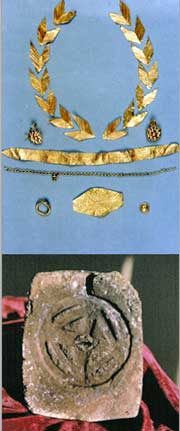Galabovo

The
chronicle of the settlement started from the ancient times. The
traces of social life in the Thracian plain which comprises the
region of Galabovo date as back as the Neolithic Age - 4000 BC.
Hisarlaka mound located at 1km from the town, in the yard of
Maritsa-Iztok 1 Thermo-Electric Power Plant is one of the most
interesting archaeological attractions from the Stone-Copper Age.
There are hypotheses that in a subsequent period the mound was
used as a fortification. It was inhabited until the middle of
the 2000 BC.
Remnants from dwellings, pottery and ceramics from the Bronze
Age and connected with the farm produce growing and keeping have
been found here.
Unique bronze jewellery
found in the necropolis of the Middle Age
fortress in the village of Iskritsa
In Galabovo region there are remnants from Thracian settlements
in the localities of Koshar Dere, Belovinite and Koriikata. The
cultural stratum is small - there are pieces of roof-tiles, pottery
and rarely pieces of ladies' jewellery. The region takes pride
in in its cultural and archaeological heritage with remnants from
many ancient dwellings and tombstones found near the villages
of Iskritsa and Madrets.
The actual biography of the settlement began in 1873 when the
106-km-long railway - part of the central railway Odrin - Plovdiv
- Tarnovo - Seimen (Simeonovgrad) - Nova Zagora - Yambol was constructed.
The first train ran at 22-35km/h - not higher than the velocity
of Vienna carriages as Konstantin Irechek noticed. The railway
station was built on land that belonged to the inhabitants of
the village of Kum Duvandjii who estimated the economic importance
of the acquisition. New taverns, inns, groceries, and store houses
sprang here together with the new homes of the people.
During the times of the Ottoman rule, south of Sweet Well quarter,
near the left bank of the Sazliika river there was a small primitive
water-mill. Immediately after the railway construction the Poulevi
brothers built another water-mill, on the left bank of the river
but north of the above mentioned quarter. It had modern for that
time equipment and was known as the "French water-mill".
The railway station changed several names - Karabunar, Sladak
Kladenets, etc. In 1969 the railway station and the village emerged
and became a town called Galabovo.
The first post office was opened in 1893. In 1905 the first primary
school was established and 17 years later it turned into a secondary
school. An agricultural school has existed since 1927 in the territory
of Railway station of Galabovo. Students from the neighbouring
villages study here. The first Prosveta Chitalishte (Prosveta
Reading club) was established in 1911.The reading clubs in Bulgaria
sprang up as early as the 19th century in nearly every town and
village and provided a communal forum for cultural and social
activities. In 1916 when the World War I started the reading club
stopped its activity but resumed it 5 years later. The administration
of the reading club organised theatrical performances, lectures,
film shows, etc.The first film projector was bought in 1930.
The year of 1920 turned to be very important for Galabovo as
the brickyards started working. A branch Bulgarian Agricultural
Bank was opened in the same year. A spinning factory started working
in 1937.
Men of enterprise and experienced in commerce could apply here
their abilities and accumulated capitals.
The town turned into an important economy centre.
The rapid development of Galabovo is due to Maritsa Iztok Thermal
Power Plant